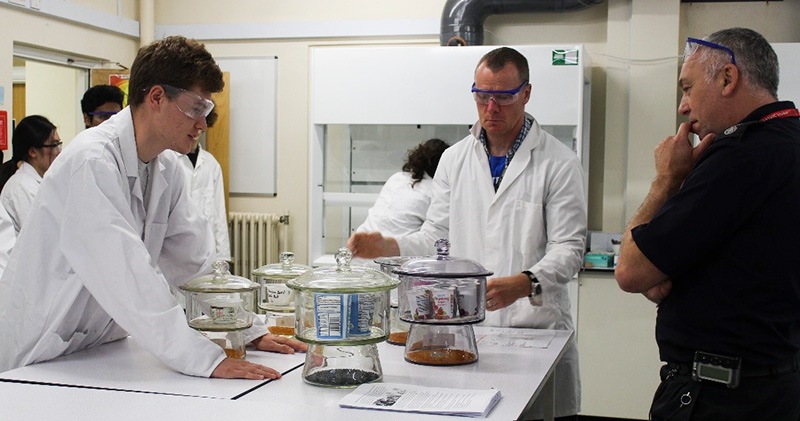11th November 2019
Collaboration between BHASVIC and East Sussex Fire and Rescue Service
On 23rd October five of our A level chemistry students presented the findings of a year’s worth of Research – conducted once a month – into the flammability of a range of commercially available peat composts. This built on previous years’ work on this project which began in 2017, when a number of callouts to ESFRS were due to peat in outdoor plant pots catching fire, but it was not clear how the fire started. We were asked to look into possible reasons/trends behind this phenomenon and have spent three years investigating different methods of ignition and the peats’ responses to various attempts to light them. This was done by drying samples of them in a dessicator and taking small uniform amounts each month and testing ignition using a spark gun, a lit wooden splint and a glowing wooden splint.
The previous two years’ work allowed us to eliminate certain brands of peat as they simply were not lighting, instead focusing on two brands that had started to show signs of combustion once they had begun to dry out. We also started looking at the effects of compaction on peat flammability with an ingenous system designed by one of our students.
Below are some pictures of when the ESFRS officers came in to find out what conclusions we arrived at. All the work was conducted and largely led by the students themselves. There are a number of benefits of this project in terms of the students’ prospects and future employment:
- A unique ongoing “real-time” piece of research that is not being conducted anywhere else to the best of our knowledge.
- The work carried out year on year is decided on by the students themselves, depending on the previous year’s conclusions and inputs from the Fire Officers at ESFRS. The next cohort of participants are recruited by inviting first year students to attend the presentation so that they see for themselves the benefits of involvement.
- Covers employability skills such as decision making, presentation, resourcefulness and problem solving.
- The transfer from one group (second year) to the other (first year) allows a unique level of cross-cohort collaboration, much like what would be part of working as a team in a laboratory.

Our students with the certificates presented to them by Richard Moon (ESFRS Lead Forensics Investigator) and Tom Walby (ESFRS Fire Officer)
L-R: Richard Moon (ESFRS), Xan McCollum, Ruby Spratt, Yiling Looi, Jason O’Grady (BHASVIC Chemistry), Rebecca Zand, Olly Tomes, Tom Walby (ESFRS)
Olly demonstrates his compaction system using weight stacks to represent various degrees of compaction.
Click here to see the slides written and used by the students to present their ideas.
